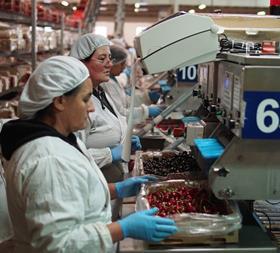
The 2017/18 Chilean cherry campaign is shaping up to be the biggest yet, with exports set to reach almost 32m cartons, up from 19m cartons last season.
Growers say the absence of frosts or heavy rainfall coupled with a sufficient amount of chill hours has produced a bumper crop, with excellent quality and firmness levels that should enable the fruit to reach the market in peak condition.
Harvesting is running between a week to 10 days later this year, depending on the production zone.
Such is the jump in volumes that packhouses will be operating at close to full capacity once the season gets into full swing, prompting fears over whether they will be able to process the fruit quickly enough.
Exporters have also expressed doubts about the likely impact on prices of heavy arrivals on the Chinese market during peak shipment weeks.
Terminal Pacífico Sur (TPS) will load the first shipment of Chilean cherries for the Chinese market this week, signalling the start of the 2017/18 fruit export season.
The Santa Rita vessel, operated by ASPA, will run weekly shipments to China in the run up to the Chinese New Year celebration in February 2018.
TPS, which runs the concession to Valparaíso’s Terminal 1, told Mundo Marítimo that by mid-January some 100,000 tonnes or 4,000 containers of cherries will have passed through the terminal. It will also handle around 70,000 tonnes of blueberries, 65,000 tonnes of table grapes, 58,000 tonnes of avocados and 30,000 tonnes of peaches.
Javier Valderrama, commercial manager at TPS said the company was very well prepared for the coming fruit season.
“We recently took delivery of a new Liebherr mobile crane with the capacity to lift 65 tonnes and serve Super post-Panamax vessels, which will enable us to load fruit with even greater efficiency and flexibility,” he said.
The terminal saw a 79.2 per cent rise in shipments last season after completing a 120-metre extension to its docking area.
The addition of MSC’s new service to the US East Coast and Europe, along with more frequent services from other carriers such as ASPA and Eurosal also helped boost the volume of fruit shipments in 2016/17.
TPS Valparaíso is the main exit point for Chilean fruit exports, handling around a third of the total volume shipped last season.
Separately, Asoex organised a special workshop for Chinese fruit importers at Huizhan Fruit Market in Shanghai last week to mark the launch of the new season.
Charif Christian Carvajal, Asoex’s marketing director for Asia and Europe, said the event was an opportunity to present the latest forecasts for the new season and look back at last season’s performance, as well as to outline the promotional campaign that Chile is planning this year, which will once again focus on cherries and blueberries.
During the event, Carvajal highlighted some of the challenges facing the Chilean fruit industry, including securing access to the Chinese market for its pears and citrus, and increasing consumption of other products such as cherries, blueberries, avocados and nectarines.
The Asian market receives almost 19 per cent of Chile’s total fruit export volume, with China accounting for around 50 per cent of this.



